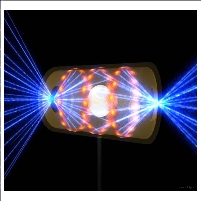World’s Most Powerful Laser Powers Up
Wednesday, April 01, 2009
 Artist's rendering of laser beams and a target pellet (Lawrence Livermore National Laboratory)
Artist's rendering of laser beams and a target pellet (Lawrence Livermore National Laboratory)
Ever since scientists first split the hydrogen atom in the 1950s as part of the U.S. government’s nuclear weapons research program, experts have dreamed of developing a new, seemingly limitless energy supply through the process of fusion. This June, researchers at the National Ignition Facility (NIF), part of Lawrence Livermore National Laboratory, hope to finally demonstrate the first practical source of fusion energy when 192 giant laser beams will be fired at once towards a single pellet of hydrogen fuel. Scientists will deem the experiment a success if they manage to extract more energy from breaking up the hydrogen pellet than was required to ignite the lasers.
Fusion naturally occurs in the sun and other stars, where massive gravitational pressure allows the process to happen at temperatures of approximately 10 million degrees Celsius. But to achieve the same results on Earth, where pressure is much lower, scientists must artificially recreate temperatures above 100 million degrees Celsius in a controlled facility, like the National Ignition Facility, to bring about fusion.
The United States is not alone in trying to finally capture this “Holy Grail” of energy research. Scientists in Europe hope to build upon the success of their American counterparts at the NIF, where lasers can only be fired every few hours, with the development of HiPer (High Power Laser Energy Research), which will have the ability to fire numerous lasers every few seconds. Also, an international effort led by France is constructing a mammoth fusion experiment, the International Thermonuclear Experimental Reactor (ITER), in Cadarache.
-Noel Brinkerhoff
Giant Laser Experiment Powers Up (BBC News)
Livermore Lab's National Ignition Facility is Gearing Up to Focus on the Inner Workings of Planets and Stars, Fusion Energy Research (by Jyllian Kemsley, Chemical & Engineering News)
National Ignition Facility (Lawrence Livermore National Laboratory)
- Top Stories
- Unusual News
- Where is the Money Going?
- Controversies
- U.S. and the World
- Appointments and Resignations
- Latest News
- Musk and Trump Fire Members of Congress
- Trump Calls for Violent Street Demonstrations Against Himself
- Trump Changes Name of Republican Party
- The 2024 Election By the Numbers
- Bashar al-Assad—The Fall of a Rabid AntiSemite






Comments